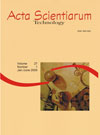Estimation of the maximum wind fetches in Ilha Solteira, state of São Paulo, reservoir
DOI:
https://doi.org/10.4025/actascitechnol.v29i1.112Keywords:
onda, pista de vento, onda em lagoAbstract
Most methods employed to estimate the height of waves generated by the wind require the surface length over which the wind blows. The choice of method depends on the nature of the water body, being applicable to ocean areas or interior water bodies, such as bays, lakes and reservoirs. One of the usual solutions has been the direct usage of the method validated in ocean waters for interior waters, therefore, not taking into consideration the effect of the restriction imposed by the shores. Nevertheless, the excessive quantity of operations of the method applied to interior water bodies (where the shore is a restraint condition) may not assure a satisfactory precision degree, unless an accurate enough graphic base of the shore with the addition of the operator´s subjectivity is used. Thus, this scientific community brings this discussion to light, proposing a classic solution based on the application of the adequate method to interior waters (Saville et al., 1954), via automatized processing. Therefore, a program in AutoLISP, a computational language, has been developed. The application of the program has determined the maximum wind fetches in Ilha Solteira, state of São Paulo, reservoir as being between 9.5 and 12.5 km, in contrast with a previous study which has predicted far longer fetches (factor of three).Downloads
Download data is not yet available.
Downloads
Published
2007-12-18
How to Cite
Marques, M., Maciel, G. de F., & Sobrinho, M. D. (2007). Estimation of the maximum wind fetches in Ilha Solteira, state of São Paulo, reservoir. Acta Scientiarum. Technology, 29(1), 79–84. https://doi.org/10.4025/actascitechnol.v29i1.112
Issue
Section
Civil Engineering
License
DECLARATION OF ORIGINALITY AND COPYRIGHTS
I Declare that current article is original and has not been submitted for publication, in part or in whole, to any other national or international journal.
The copyrights belong exclusively to the authors. Published content is licensed under Creative Commons Attribution 4.0 (CC BY 4.0) guidelines, which allows sharing (copy and distribution of the material in any medium or format) and adaptation (remix, transform, and build upon the material) for any purpose, even commercially, under the terms of attribution.
Read this link for further information on how to use CC BY 4.0 properly.
0.8
2019CiteScore
36th percentile
Powered by 



0.8
2019CiteScore
36th percentile
Powered by 

















8.png)




